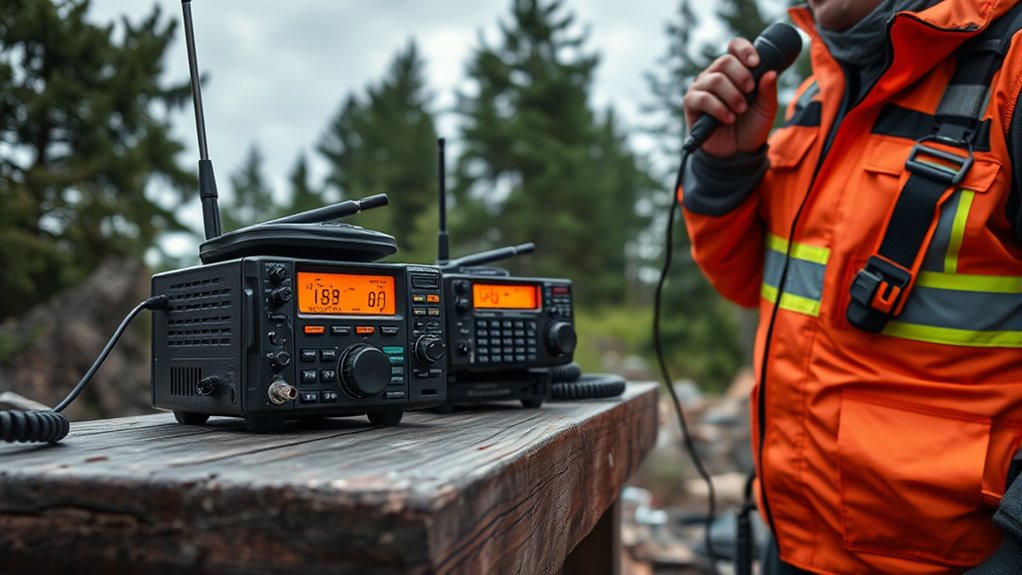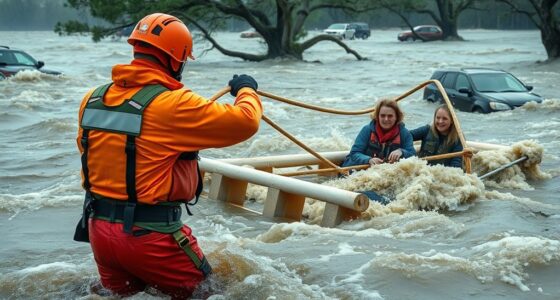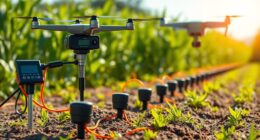Using HAM and CB radios is crucial for emergency communication because they enable you to stay connected when phone lines and internet fail. Proper antenna installation, placement, and regular maintenance improve signal range and clarity, ensuring vital links during crises. Power backup systems keep your radios functional without electricity. By understanding setup and upkeep, you can boost reliability and response time. Keep exploring, and you’ll discover essential tips to make your emergency communication setup more resilient and effective.
Key Takeaways
- HAM radios offer long-range, reliable communication during emergencies, often requiring licensing and proper antenna setup.
- CB radios are license-free and suitable for short to medium-range emergency communication among local users.
- Proper antenna installation, including height and orientation, enhances signal clarity and communication range for both radio types.
- Maintaining backup power sources like batteries ensures continuous operation when mains power is unavailable.
- Regular testing and organized setup improve response efficiency and help establish dependable communication links during crises.

Have you ever wondered how emergency responders stay connected during a crisis? When disaster strikes, reliable communication becomes essential, and that’s where HAM and CB radios come into play. These radios serve as vital tools for both professionals and everyday users, ensuring that help can be coordinated quickly and efficiently. To make sure your radio setup performs optimally during an emergency, proper antenna installation is crucial. A well-installed antenna not only extends your communication range but also provides a clearer signal, reducing the chances of miscommunication when it matters most. Whether you’re setting up a mobile or base station, investing time in correct antenna placement—considering height, orientation, and surroundings—can significantly improve your radio’s performance. Additionally, securing your antenna properly prevents damage from environmental factors like wind or storms, maintaining consistent communication lines during critical moments. Correct antenna installation can also help prevent interference from nearby electronic devices, further enhancing signal clarity. Equally important is the inclusion of a reliable battery backup. Power outages are common during emergencies, and your radio equipment needs to stay operational regardless of electrical failures. By connecting your HAM or CB radio to a dedicated battery backup system, you ensure continuous communication even when the main power source is compromised. Portable battery packs or deep-cycle batteries are popular choices, offering enough capacity to keep your radio running through extended crises. This backup power not only sustains your ability to communicate but also allows you to relocate or operate your radio in areas without electrical outlets. Regularly testing your battery backup system helps identify potential issues beforehand, so you’re not caught unprepared when disaster strikes. Properly understanding and maintaining your backup power setup can greatly enhance your readiness and reliability during emergencies. Furthermore, understanding the importance of antenna placement and its impact on signal strength can make a significant difference during emergencies. Combining proper antenna installation with a dependable battery backup creates a resilient communication setup that can withstand the chaos of a crisis. Taking these steps might seem technical, but they’re straightforward investments in your safety. When installing your antenna, remember that height and clear line-of-sight are key to maximizing coverage. For battery backup, ensure your batteries are fully charged, stored safely, and easily accessible. These preparations allow you to quickly set up and operate your radio, maintaining vital links with emergency services, neighbors, and loved ones. Additionally, regular maintenance of your communication equipment ensures it remains in optimal condition and ready for use when needed. Ultimately, your ability to communicate during emergencies hinges on these foundational setups, giving you peace of mind knowing that your system is ready to perform when it’s needed most. Proper maintenance and understanding of your emergency communication equipment can further improve your preparedness, ensuring reliability in critical moments.
Frequently Asked Questions
What Are the Legal Restrictions on Emergency Radio Communications?
You should know that legal restrictions require licensed operation of radios to prevent interference with other communications. You can’t transmit on unauthorized frequencies or use your radio for illegal activities. Managing interference is vital, so avoid disrupting emergency services or other licensed users. Following these restrictions ensures you’re compliant with regulations and helps keep emergency communications clear and effective when needed. Always adhere to licensing and interference management rules to stay within legal boundaries.
How Do HAM and CB Radios Differ in Emergency Situations?
In emergency situations, ham radios offer greater versatility with various antenna types and higher power options, allowing you to reach more distant stations. CB radios are simpler, with fixed antennas and lower power, but they’re easy to operate and reliable. You should regularly maintain your batteries and check antenna connections to guarantee clear communication. Your choice depends on your needs, but both can be crucial tools in emergencies.
What Training Is Necessary to Operate Emergency Radios Effectively?
You need proper training to operate emergency radios effectively. Start by understanding antenna installation to guarantee clear signals and learn how to set up a reliable battery backup for power outages. Practice radio procedures, including call signs and message clarity, so you can communicate smoothly during emergencies. Familiarity with equipment and protocols helps you respond quickly and confidently, making your communication more dependable when it matters most.
How Can I Ensure My Radio Works During a Power Outage?
To guarantee your radio works during a power outage, you need to focus on antenna maintenance and battery backups. Regularly check and secure your antenna to maintain clear communication. Keep your batteries charged and have spare backups ready. Consider investing in a portable power source or uninterruptible power supply (UPS) to keep your radio operational. Test your setup periodically to guarantee everything functions smoothly when you need it most.
Are There Specific Channels Designated for Emergency Communications?
Many believe there are no specific channels for emergencies, but in reality, certain channel protocols are dedicated for urgent situations. You should know these channels and include them in your emergency kits. By practicing proper channel protocols now, you guarantee you’re prepared when disaster strikes. Having quick access to designated emergency channels can make all the difference, helping you stay connected and informed when it matters most.
Conclusion
In emergencies, your radio can be a lifeline, connecting you when all else fails. While smartphones rely on networks that might be down, ham and CB radios operate independently, offering a resilient backup. Imagine the difference it makes—silent streets, yet your radio signals cut through the chaos. Don’t wait for disaster to strike; equip yourself now. Because in moments of crisis, it’s not just technology—it’s your link to safety and hope.










